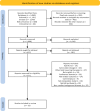Safety and Effectiveness of High-Intensity Statins Versus Low/Moderate-Intensity Statins Plus Ezetimibe in Patients With Atherosclerotic Cardiovascular Disease for Reaching LDL-C Goals: A Systematic Review and Meta-Analysis
- PMID: 39135464
- PMCID: PMC11319735
- DOI: 10.1002/clc.24334
Safety and Effectiveness of High-Intensity Statins Versus Low/Moderate-Intensity Statins Plus Ezetimibe in Patients With Atherosclerotic Cardiovascular Disease for Reaching LDL-C Goals: A Systematic Review and Meta-Analysis
Abstract
Background: It remains controversial whether adding ezetimibe to low/moderate-intensity statins has a more beneficial impact on the treatment efficacy and safety of patients with existing atherosclerotic cardiovascular disease (ASCVD) compared to high-intensity statin regimens.
Hypothesis: A combination of low/moderate-intensity statins plus ezetimibe might be more effective and safer than high-intensity statin monotherapy.
Methods: We searched databases for randomized controlled trials comparing lipid profile alterations, drug-related adverse events, and MACE components between high-intensity statin monotherapy and low/moderate-intensity statin plus ezetimibe combination therapy. Pooled risk ratios (RR), mean differences (MD), and 95% confidence intervals (95% CI) were estimated using a random-effects model.
Results: Our comprehensive search resulted in 32 studies comprising 6162 patients treated with monotherapy against 5880 patients on combination therapy. Combination therapy was more effective in reducing low-density lipoprotein cholesterol (LDL-C) levels compared to monotherapy (MD = -6.6, 95% CI: -10.6 to -2.5); however, no significant differences were observed in other lipid parameters. Furthermore, the combination therapy group experienced a lower risk of myalgia (RR = 0.27, 95% CI: 0.13-0.57) and discontinuation due to adverse events (RR = 0.61, 95% CI: 0.51-0.74). The occurrence of MACE was similar between the two treatment groups.
Conclusions: Adding ezetimibe to low/moderate-intensity statins resulted in a greater reduction in LDL-C levels, a lower rate of myalgia, and less drug discontinuation compared to high-intensity statin monotherapy in patients with existing cardiovascular disease. However, according to our meta-analysis, the observed reduction in LDL-C levels in the combination group did not correlate with a reduction in MACE compared to the high-intensity statin group.
Keywords: atherosclerosis; ezetimibe; meta‐analysis; statin; systematic review.
© 2024 The Author(s). Clinical Cardiology published by Wiley Periodicals, LLC.
Conflict of interest statement
The authors declare no conflicts of interest.
Figures




References
-
- Arnett D. K., Blumenthal R. S., Albert M. A., et al., “2019 ACC/AHA Guideline on the Primary Prevention of Cardiovascular Disease: Executive Summary: A Report of the American College of Cardiology/American Heart Association Task Force on Clinical Practice Guidelines,” Circulation 140, no. 11 (2019): e563–e595. - PMC - PubMed
-
- Wilemon K., MacDougall D., McGowan M., Howard W., and Myers K., “71% of High Risk Hypercholesterolemia Patients Never Reach ACC AHA Guidelines,” supplement, Journal of the American College of Cardiology, 81, no. 8_Suppl (2023): 1231. - PubMed
-
- Grundy S. M. and Stone N. J., “2018 American Heart Association/American College of Cardiology/Multisociety Guideline on the Management of Blood Cholesterol–Secondary Prevention,” JAMA Cardiology 4, no. 6 (2019): 589–591. - PubMed
Publication types
MeSH terms
Substances
Grants and funding
LinkOut - more resources
Full Text Sources
Medical

